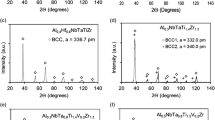The particular features of structure formation in high-nitrogen austenitic steels characterized by intermittent decomposition of solid solution and ductile-brittle transition are considered. The effects of heat treatment, thermoplastic treatment, and alloying elements on the physical and mechanical properties of high-nitrogen austenitic steels are considered. Possibilities for using such steels as structural materials are analyzed.








Similar content being viewed by others
Change history
20 June 2020
To the article ���Structural Features and Application Prospects for High-Nitrogen Austenitic Steels,��� by O. A. Bannykh, Vol. 61, Nos. 5 ��� 6, pp. 287 ��� 294, September, 2019.
References
I. O. Bannykh and A. M. Glezer, “Main principles of alloying and treatment of high-nitrogen austenitic corrosion-resistant steels,” Deform. Razrush. Mater., No. 6, 2 – 6 (2018).
I. O. Bannykh and O. A. Bannykh, Contemporary State of Research and Application of High-Nitrogen Austenitic Steels [in Russian], Nauka i Tekhnol., Moscow (2017).
T.-H. Lee, S.-T. Kim, and S. Takaki, “Time-temperature-precipitation characteristics of high-nitrogen austenitic Fe – 18Cr – 18Mn – 2Mo – 0.9N steel,” Metall. Mater. Trans. A, 37(12), 3445 – 3454 (2006).
L. Rovatti, R. Montanari, N. Ucciardello, et al., “Discontinuous precipitation in a high-nitrogen austenitic steel,” Mater. Sci. Forum, 638 – 642, 3597 – 3602 (2010)
Z. Z., Yuan, Q. X. Dai, X. N. Cheng, and K. M. Chen, “Microstructural thermal stability of high nitrogen austenitic stainless steel,” Mater. Charact., 58(1), 87 – 91 (2007).
L. G. Rignia, Study and Development of ESR and ESRD of Chromium-Manganese Steels Alloyed with Nitrogen, Author’s Abstract of Candidate’s Thesis [in Russian], NPO TsNIITMASh, Moscow (2005).
O. A. Bannykh and V. M. Blinov, “On the structure and properties of high nitrogen low-carbon non austenitic steels,” Steel Res., 65(5), 178 – 183 (1994).
I. O. Bannykh, M. A. Sevost’yanov, and M. E. Prutskov, “Effect of heat treatment on the mechanical properties and the structure of a high-nitrogen austenitic 02Kh20AG10N4MFB steel,” Russian Metallurgy (Metally), No. 7, 613 – 618 (2016) (DOI: https://doi.org/10.1134/S0036029516070065).
L. Hua-Bing, J. Zhou-Hua, F. Hao, et al., “Aging precipitation behavior of 18Cr – 16Mn – 2Mo – 1.1N high nitrogen austenitic stainless steel and its influences on mechanical properties,” J. Iron Steel Res. Int., 19(8), 43 – 51 (2012) (DOI: https://doi.org/10.1016/S1006-706X(12)60138-1).
H. Byoungchul, L. Tae-Ho, P. Seong-Jun, et al., “Correlation of austenite stability and ductile-to-brittle transition behavior of high-nitrogen 18Cr – 10Mn austenitic steels,” Mater. Sci. Eng. A, 528(24), 7257 – 7266 (2011) (DOI: https://doi.org/10.1016/j.msea. 2011.06.025).
L. R. Botvina, V. M. Blinov, M. R. Tyutin, et al., “Fracture of high nitrogen 05Kh20G10N3AMF steel during impact loading,” Russian Metallurgy (Metally), No. 3, 239 – 247 (2012) (DOI: https://doi.org/10.1134/S0036029512030044).
I. O. Bannykh “Correlation of the grain structure and mechanical properties for high-nitrogen austenitic steel 02Kh20AG10N4MFB after annealing,” Deform. Razrush. Mater., No. 12, 25 – 29 (2015).
I. O. Bannykh “Effect of alloying on the strength properties and the hardening mechanisms of nitrogen-bearing austenitic steels after hot deformation and annealing,” Russian Metallurgy (Metally), No. 11, 968 – 973 (2017).
M. A. Shtremel’, Alloy Strength. Part 1: Lattice Defects [in Russian], MiSIS, Moscow (1999).
S. S. Gorelik, S. V. Dobatkin, and L. M. Kaputkina, Recrystallization of Metals and Alloys [in Russian], MiSIS, Moscow (2005).
I. O. Bannykh, “Effect of quenching conditions on the formation of the grain structure and the mechanical properties of high nitrogen austenitic 02Kh20AG14N8MF and 02Kh20AG12N4 steels,” Russian Metallurgy (Metally), No. 11, 876 – 879 (2015) (DOI: https://doi.org/10.1134/S003602951511004X).
Work was conducted within the scope of a state assignment No. 007-00129-18-00.
Author information
Authors and Affiliations
Corresponding author
Additional information
Translated from Metallovedenie i Termicheskaya Obrabotka Metallov, No. 5, pp. 22 – 29, May, 2019.
Rights and permissions
About this article
Cite this article
Bannykh, O.A. Structural Features and Application Prospects for High-Nitrogen Austenitic Steels. Met Sci Heat Treat 61, 287–294 (2019). https://doi.org/10.1007/s11041-019-00418-x
Published:
Issue Date:
DOI: https://doi.org/10.1007/s11041-019-00418-x




